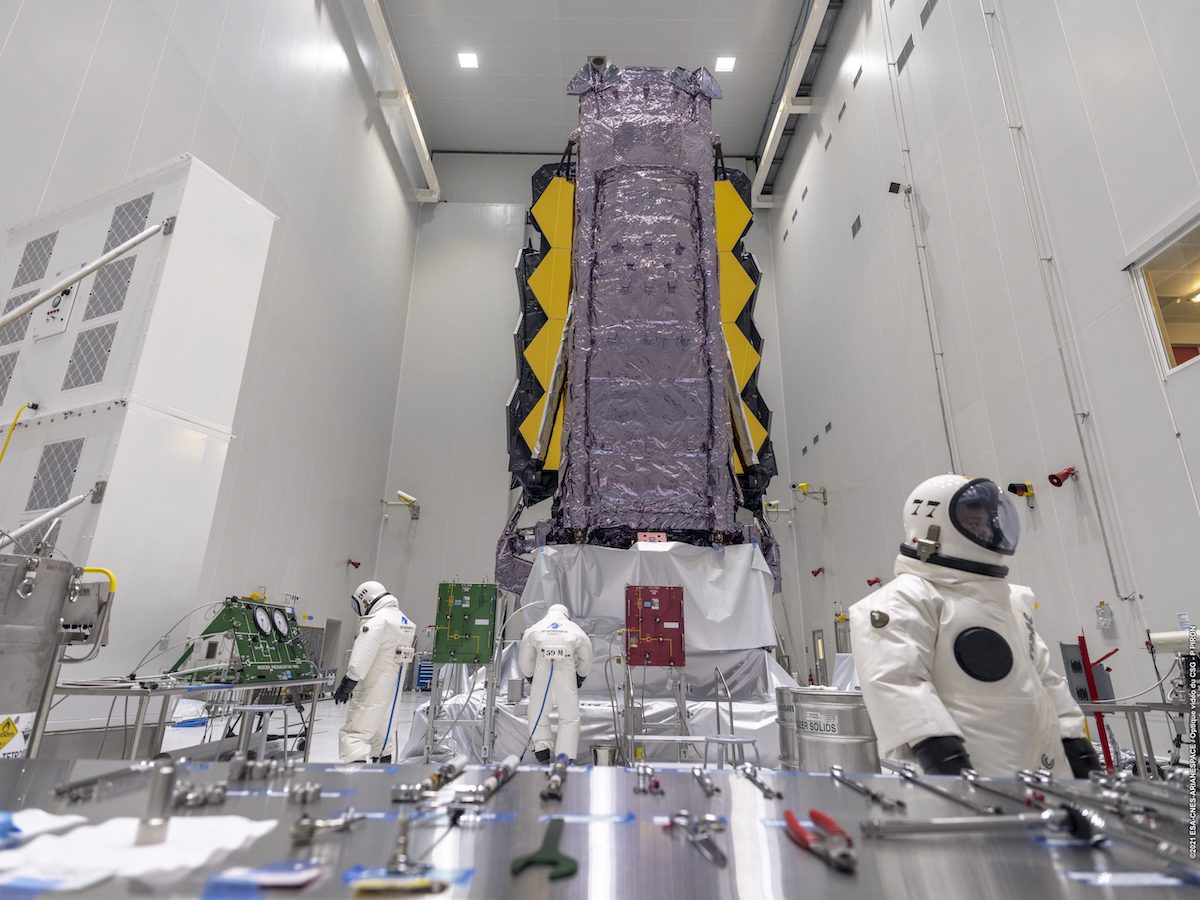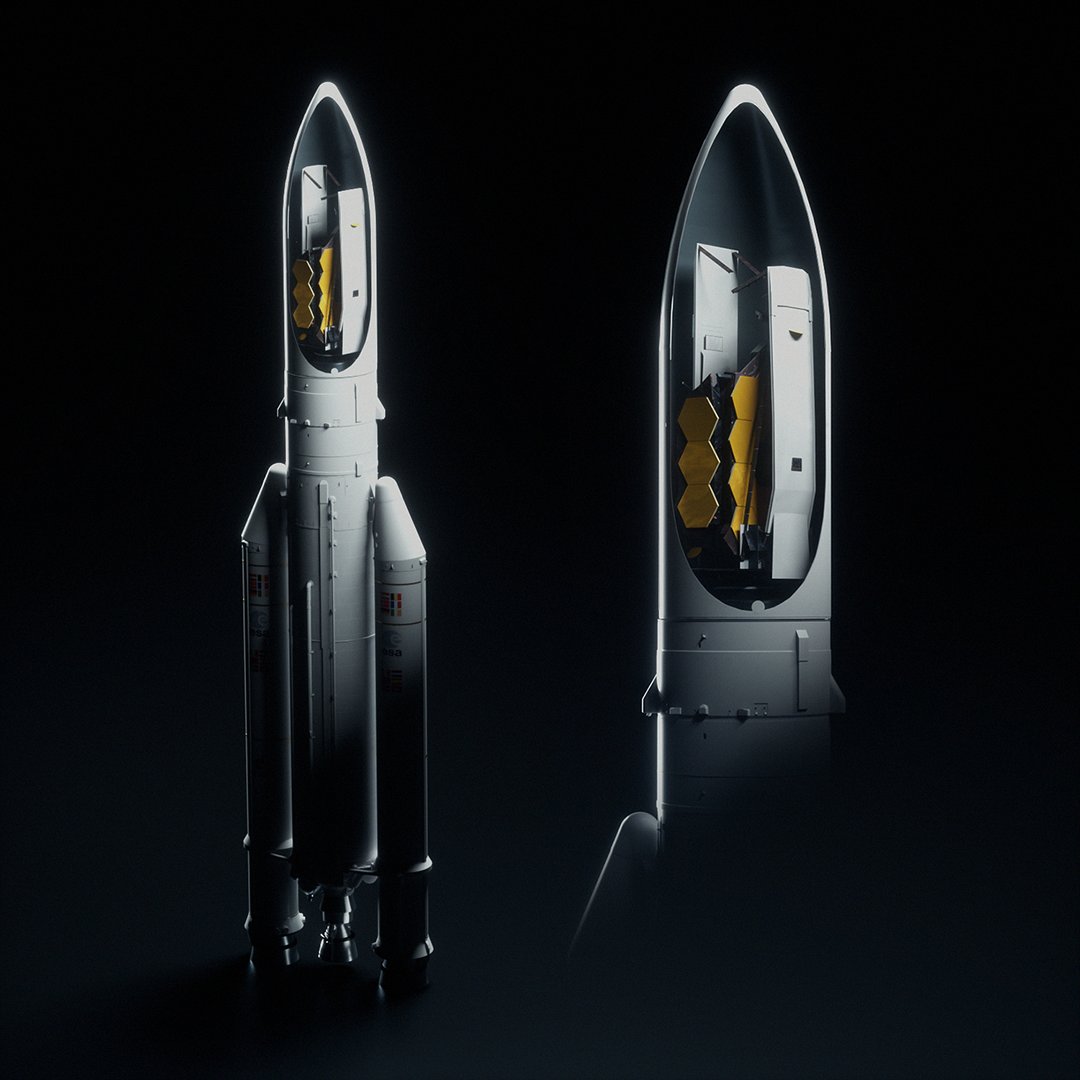
A crane at the Guiana Space Center in South America will hoist the nearly $10 billion James Webb Space Telescope more than 15 stories above the floor of a rocket assembly hangar this weekend to position the observatory on top of its Ariane 5 launcher for blastoff later this month.
The delicate operation, accomplished with perfection before 111 previous Ariane 5 missions, will take most of the day to complete Saturday. If all goes well, engineers will put their hands on Webb for the final time Sunday before enclosing the 35-foot-tall (10.66-meter) observatory inside the Ariane 5’s Swiss-made payload fairing Monday.
“The next major step will be on this Saturday, and we will integrate the observatory onto the launcher,” said Thierry Wilmart, mission director for the Webb launch at Arianespace, the Ariane 5’s commercial operator. “It will be, of course, a major and sensitive operation, so basically we have a full review with the spacecraft project to review the whole operation, all the steps.”
The James Webb Space Telescope is a joint program between NASA, the European Space Agency, and the Canadian Space Agency. NASA, the senior partner, developed Webb’s spacecraft bus, thermal shield, and the telescope itself, the largest ever sent into space. NASA was also responsible for part of Webb’s infrared instrument package.
ESA is providing the launch on an Ariane 5 rocket and supplied other elements of the instruments to collect reams of data from the cosmos. Canada provided instrument parts and a guidance sensor to keep Webb tightly pointed on its celestial targets.
A quarter-century in the making, Webb is now less than two weeks from leaving Earth, bound for a gravitationally-stable region known as L2, a Lagrange point a million miles away. The new space-based observatory will see farther into the universe, and farther back in time, than the Hubble Space Telescope, gathering imagery of the earliest galaxies after the Big Bang more than 13 billion years ago.
Webb will also study how stars form, and measure the composition of the atmospheres of planets around other stars.
The connection of Webb with its European launch vehicle follows caps nearly two months of standalone processing with the observatory since its arrival at the spaceport in Kourou, French Guiana, in October. Engineers checked that the observatory survived the trip to French Guiana from its factory in California, then mated Webb with the adapter ring that will attach to the top of the Ariane 5’s upper stage.
During that step of Webb’s preparations, a clamp band that connects the spacecraft to the payload adapter unexpectedly opened, sending a vibration throughout the observatory. Engineers re-tested elements of the spacecraft to make sure it wasn’t damaged in the incident, then gave the green light to load propellants into the spacecraft beginning Nov. 25.

Working inside Arianespace’s satellite preparation facility, technicians wearing self-contained protective suits loaded the toxic hydrazine fuel and dinitrogen tetroxide propellants into tanks at the base of the observatory. The load consisted of 661 pounds (301 kilograms) of liquid propellant — 369 pounds (168 kilograms) of fuel and 292 pounds (133 kilograms) of oxidizer.
The propellants will feed the mission’s 20 rocket thrusters.
Four of the small engines — a primary and redundant thruster in two pods — will consume fuel and oxidizer for major course correction maneuvers. Webb has eight more thruster modules, each with two small hydrazine-fed engines to nudge the observatory with a single pound of thrust, providing pointing control in concert with spinning reaction wheels inside the spacecraft.
The fuel loading system was disconnected from Webb on Dec. 3, according to NASA.
Technicians also loaded helium pressurant into the spacecraft, then placed Webb into a climate-controlled transport carrier for a trip by road a few miles northwest to the Ariane 5 rocket’s final assembly building — known in French as the Batiment d’Assemblage Final, or BAF — on Tuesday night.
The Ariane 5 rocket, consisting of its hydrogen-fueled cryogenic core stage, two solid rocket boosters, and upper stage, was built up inside the launcher integration building at the Guiana Space Center beginning Nov. 6. Teams transferred the rocket, without Webb or its payload fairing, to the final assembly building on its vertical launch table Nov. 29, setting the stage for arrival of the observatory after fueling.
With Webb now on the verge of meeting its ride to space, the launch campaign is now in the “combined operations” phase leading up to the mission’s target blastoff date of Dec. 22.
Lifting expensive, one-of-a-kind spacecraft on top of the vertical Ariane 5 rocket is “always a sensitive operation” Wilmart said. Most Ariane 5 payloads are valued at a few hundred million dollars. A few, such as ESA interplanetary science missions, have cost more than $1 billion.
Webb will be the most expensive space science mission ever launched.
“We avoid as much as possible to move the spacecraft with the crane, which means the next time we do it, it’s for the integration on the launcher,” Wilmart said this week in a phone interview with Spaceflight Now.

Once Webb is fastened to the top of the Ariane 5 rocket Saturday, ground teams will take off the final protective covers from thrusters and other parts of the spacecraft Sunday. After pulling off the red “remove before flight” items, teams will give the green light to encapsulate Webb inside the Ariane 5 rocket’s 17.7-foot (5.4-meter) diameter nose cone.
“Once on the launcher, we want to encapsulate as quick as possible,” Wilmart said. “We don’t want to have too long of a duration with the observatory on the launcher without the fairing because after the encapsulation, it will be under the fairing with the adequate ventilation and the protection of the fairing with regard to the environment.
“So we all agreed to go (quickly) during three days … It is mainly because of this (will) have these three major operations on three consecutive days.”
“From Monday afternoon, the observatory won’t be visible any more,” Wilmart said.
Webb will fill the Ariane 5’s nose fairing, one of the largest payload shrouds of any operational rocket. When a crane lowers the fairing over Webb, some pieces of the observatory will have just 8 inches of clearance, according to Daniel de Chambure, acting head of the Ariane 5 rocket’s adaptation program at ESA.
A laser alignment system will ensure the encapsulation goes off without a hitch, Wilmart said.
With Webb encapsulated in the fairing, officials in French Guiana will turn their attention to a launch dress rehearsal Dec. 15, including the spacecraft, launch vehicle, and range safety teams. Next Friday, Dec. 17, managers will meet for a launch readiness review to discuss the status of all systems for rollout of the Ariane 5 from the final assembly building to the ELA-3 launch pad.
Wilmart said Arianespace and NASA teams have two days of schedule cushion for the Dec. 22 launch date, which itself is a four-day delay from a previous target date. The four-day slip allowed time for engineers to re-test components on Webb after the payload adapter incident last month.
If everything remains on schedule, officials will take two days off next weekend to rest up before the final push toward launch.
The Ariane 5 is scheduled to emerge from the final assembly building for the 1.7-mile (2.7-kilometer) trip to the ELA-3 launch pad Dec. 20. It will ride on its mobile launch platform along rail tracks, pulled by a diesel-powered tug.
The half-day countdown will commence late Dec. 21 and proceed through loading of cryogenic liquid hydrogen and liquid oxygen propellants into the Ariane 5 before dawn Dec. 22. Webb has a 30-minute launch window opening at 7:20 a.m. EST (1220 GMT; 9:20 a.m. French Guiana time).
The Ariane 5 will release Webb about a half-hour after launch, sending Webb on its journey to the L2 Lagrange point. Then begins a series of make-or-break deployments to configure Webb for science operations.
Email the author.
Follow Stephen Clark on Twitter: @StephenClark1.
